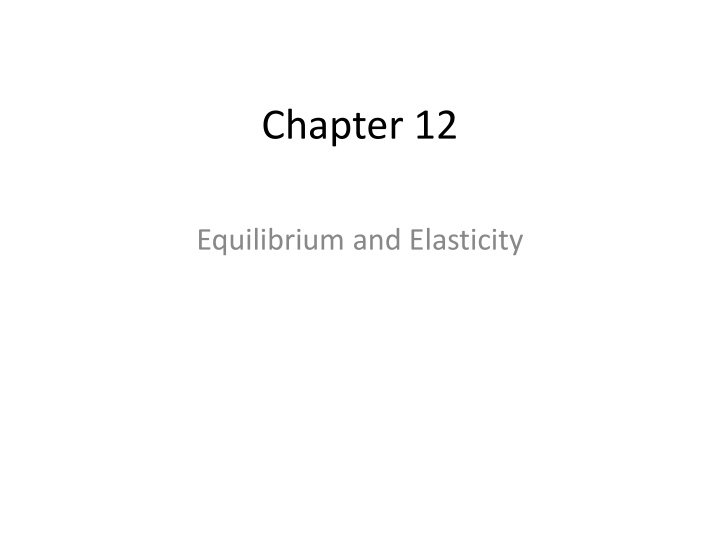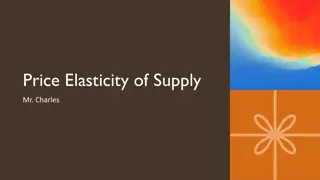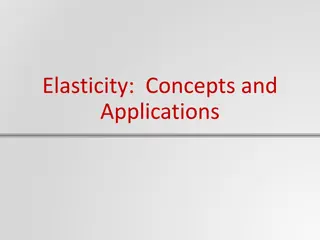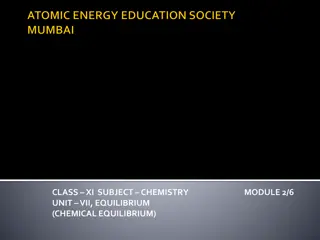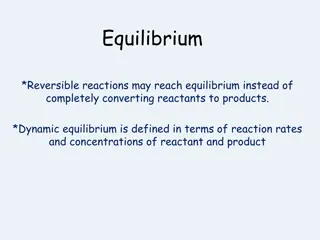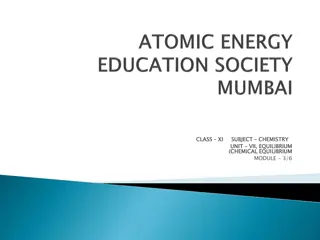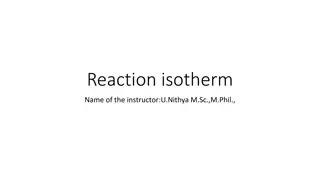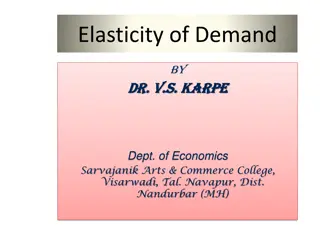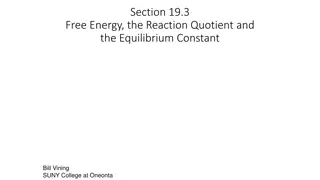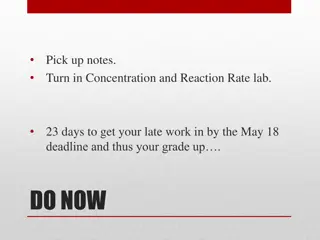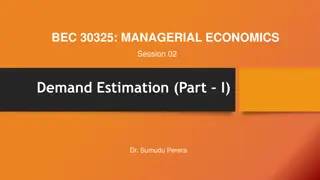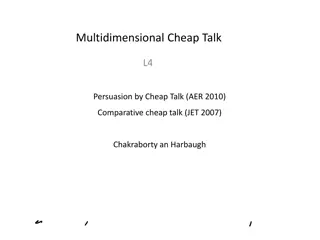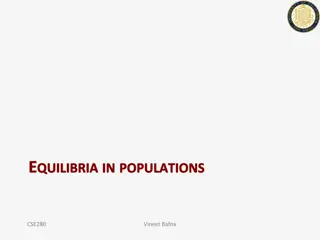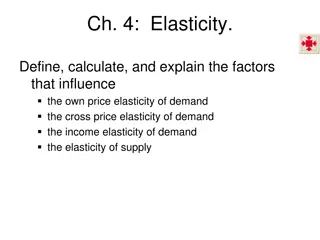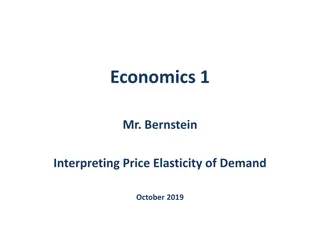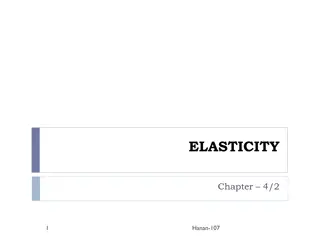Equilibrium and Elasticity Principles
Concepts of equilibrium and elasticity, including stable and unstable states, center of gravity, and conditions for static equilibrium. Learn about torques, forces, and systems at rest or in motion, with illustrative examples and diagrams provided.
Download Presentation

Please find below an Image/Link to download the presentation.
The content on the website is provided AS IS for your information and personal use only. It may not be sold, licensed, or shared on other websites without obtaining consent from the author.If you encounter any issues during the download, it is possible that the publisher has removed the file from their server.
You are allowed to download the files provided on this website for personal or commercial use, subject to the condition that they are used lawfully. All files are the property of their respective owners.
The content on the website is provided AS IS for your information and personal use only. It may not be sold, licensed, or shared on other websites without obtaining consent from the author.
E N D
Presentation Transcript
Chapter 12 Equilibrium and Elasticity
Lecture 1 Equilibrium
Center of Gravity mg mg The point at which effective gravitational force Fg acts on is called the center of gravity (cog) of the body If g is same for all elements center of mass (com) and center of gravity (cog) are consistent
Equilibrium System Stable Equilibrium Unstable Equilibrium If a small perturbation away from equilibrium is applied, the system will move farther away from its equilibrium state. Example: a pencil balanced on it's end. If a small perturbation away from equilibrium is applied, the system will return itself to the equilibrium state. Example: Pendulum Rod
Static Equilibrium System N FL FR mg Two conditions for equilibrium Net Force = 0 Net Torque = 0 F = = 0 0 p = cont = cont Translational equilibrium Rotational equilibrium
Equilibrium System = Not moving and not rotating system N1 N2 mg Total upward force = total downward Force = 0 y F Total clockwise torque = Total anticlockwise torque = 0 Total right force = total left Force F = 0 x
Axis of Rotation at mg to eliminate it from the torque equation N2 N1 Axis of rotation Anti-clockwise torque Clockwise torque N 2 L/2 L/2 N 1 L L 2 2 L = N mg L 2 2 2 = N 1 1 2 Net force in vertical direction is zero Net Torque = 0 = 0 F = 0 y + = 0 N N mg 1 2 L L + = 0 N N 1 2 2 2
Axis of Rotation at N2 to eliminate it from the torque equation N2 N1 Axis of rotation Clockwise torque L L/2 N 1 L = N1 L 1 mg Anti-clockwise torque Net force in vertical direction is zero y F L 2 = 0 Net Torque = 0 = 0 mg + = 0 N N mg 1 2 L = mg 2 2 L + = 0 N L mg 1 2
Axis of Rotation at N1 to eliminate it from the torque equation N2 N1 Axis of rotation L L/2 Anti-clockwise torque N 2 mg L Clockwise torque Net force in vertical direction is zero 0 = y F L 2= N2 L 2 Net Torque = 0 mg + = 0 N N mg L 1 2 = mg = 0 2 2 L = 0 N L mg 2 2
2. (a) no; (b) at site of , perpendicular to plane of figure; (c) 45 N Example 0 A meter stick balances horizontally on a knife- edge at the 50.0 cm mark. With two 5.00 g coins stacked over the 10.0 cm mark, the stick is found to balance at the 45.5 cm mark. What is the mass of the meter stick? A) 78.9 10 3m
Example 1 A uniform steel bar of length 3.0 m and weight 20 N rests on two supports (A and B) at its ends. A block of weight W = 30 N is placed at a distance 1.0 m from A (see Fig. 4). The forces on the supports A and B respectively are: (Ans:30 N and 20 N) Example 2 Forces F1, F2 and F3 acts on the structure of Fig 12-30, shown in the overhead view. We wish to put the structure in equilibrium by applying a forth force at a point such as P. The forth force has vector components Fh and Fv. We are given a = 2m, b = 3m, c = 1 m, F1 = 20N, F2 = 10N and F3 = 5N. Find (a) Fh, (b) Fv, and (c) d.
Example 3 Provided : m = 45 kg, L = 12m, M = 72Kg, h = 9.3m, Com of ladder = L/3, Firefighter = L/2. Find N1 and N2 Ans: (a) N2 = 410 N (b) N1 = 1100 N N2 N2 Mg N1 Mg mg N1 Ff mg Ff a/3 a/2
Example 4 m = 85 kg, M = 430 kg, a = 1.9 m and b = 2.5 m Ans: (a) Tc = 6100 N (b) Fv = 5047 N Tc Fv Tr Tc mg Fh Mg Tr Mg mg Fv Fh Mg
Example 5 Example 6: Given: Mass of the block (M) = 225 Kg, Mass of the rod (m) = 45 Kg, = 300 , = 450 To find: (a) T = ? (b) Fh = ? (b) Fv = ? T1 Tx Tcos( ) T1 Mg Ty Tsin( )+Mg T Fv mg Fv mg Mg Fh Fh
Example 6 In Fig., one end of a uniform beam of weight 222 N is hinged to a wall; the other end is supported by a wire that makes angles = 30.0 with both wall and beam. Find (a) the tension in the wire and the (b) horizontal and (c) vertical components of the force of the hinge on the beam. Fhy Fhx Fhy T Tsin( ) Fhx Tsin( ) Tcos( ) mg Tcos( ) mg
Books Problems In Fig., a uniform beam of weight 500 N and length 3.0 m is suspended horizontally. On the left it is hinged to a wall; on the right it is supported by a cable bolted to the wall at distance D above the beam. The least tension that will snap the cable is 1200 N. (a)What value of D corresponds to that tension? (b)To prevent the cable from snapping, should D be increased or decreased from that value? In Fig., one end of a uniform beam of weight 222 N is hinged to a wall; the other end is supported by a wire that makes angles = 30.0 with both wall and beam. Find (a) the tension in the wire and the (b) horizontal and (c) vertical components of the force of the hinge on the beam. The system in Fig. is in equilibrium. A concrete block of mass 225 kg hangs from the end of the uniform strut of mass 45.0 kg. For angles = 30.0 and = 45.0 , find (a) the tension T in the cable and the (b) horizontal and (c) vertical components of the force on the strut from the hinge.
Example 7 Fig. 1 shows a three boxes of masses m1, m2 and m3 hanging from a ceiling. The crossbars are horizontal and have negligible mass and same length L. If m3 = 1.0 kg, then m1 is equal to:(Ans: 12 kg ) T2 T1 3l/2 l/2 3l/2 l/2 m1 T1 m2 m3
T-92-ch12 + = 6 T T g 1 2 T2 T1 T T P2 P1 T P2 6g T1 P1 F T2 T2 T + = T1 ' T F T 1 + ' = T T T 2
T122-Q14. A uniform and symmetric sign board is supported by two strings as shown in Figure 4. Find the ratio of the tension in string 1 to the weight of the sign board. A) 0.33 T1 T2 d1 d2 mg T121-Q16. Figure 6 shows a uniform solid sphere of weight 400 N suspended by string AB and resting against a frictionless vertical wall. The string makes an angle of 60.0 with the wall. Find the magnitude of the force exerted by the wall on the sphere. A) 693 N Tsin( ) FN Tcos( ) mg
T122-Q13. A block with a weight of 10.0`kN is supported by a massless rope attached to a 4.00`m massless beam that can pivot at the base, as shown in Figure 3. Find the magnitude of the tension (T) in the rope. A) 5.08 kN T122-Q14: Figure 11 shows three situations in which a horizontal rod is supported by a hinge on a wall at one end and a cord at the other end. Rank the situations according to the magnitude of the force on the rod from the cord, greatest first. A) (1 and 3 tie) then 2
T122-Q15. A 5.0`m long, 10`kg ladder is leaning against a frictionless vertical wall, while the bottom of the ladder rests 3.0`m away from the wall on a horizontal rough floor, as shown in Figure 4. What is the magnitude of the force of static friction between the floor and the ladder? A) 37 N
Lecture 2 Elasticity
Hookes Law x x Hooks Law F = -k x Compression or elongation Force Spring Constant Hooks Law is valid within an elastic limit
Elastic Limit Elastic limit If you pull the string too hard it will rapture
Stress, strain and Yongs modulus F L A A L Stress = Force/Area of crossection Stress = F/A L L strain = elongation or compression/length Strain = L /L stress strain F L A L L F = E A L Young's Modulus
Share and Bulk Modulus F x V F L F x V A L x F V A V V F = G F A L = B A V Share Modulus Bulk Modulus
T72Q18.: A horizontal steel rod of length 81 cm and radius 9.5 mm is fixed at one end. It stretches by 0.90 mm when a horizontal force of magnitude F is applied to its free end. Find the magnitude of F (Young modulus of steel is 20 1010 N/m2). (Ans: 63 kN) T71Q3. Fig. 3 shows a uniform block of mass m = 100 kg, which is held in a horizontal position by two vertical steel rods at its ends. Each of the rods has length, L = 1.0 m, cross sectional area = 1.0 10-3 m2 and young s modulus, E =2.0 1011 N/m2 . The increase in the length of any one the rods ( L), is: (Ans: 2.5 10 6 m) T52Q#17:A shearing force F = 50 N is applied to an aluminum rod with a length of L =10 m, a cross-sectional area A=1.0 10 5 m2, and a shear modulus G = 2.5 1010 N/m2. As a result the rod is sheared through a distance ( x) of: (Ans: 0.20 cm) T61Q16. The volume of a solid Aluminum sphere at the sea level is V = 1.0 m3. This sphere is placed at a depth of about 700 m in the sea where the absolute pressure is p = 7.0 x 106 N/m2. The change in the volume ( V) of the sphere is: (the bulk modulus of Aluminum, B = 70 x109 N/m2). A) 1.0 x 10-4 m3 T62Q3. A solid copper sphere has a diameter of 85.5 cm. How much stress must be applied to the sphere to reduce its diameter to 85.0 cm? The bulk modulus of copper is 1.4 x 1011 N/m2 (Ans: 2.4 109 N/m2 )
T123 Q16: A small sphere is made of a material with a bulk modulus of 1.90 x 109 Pa. The volume of the sphere shrinks by 0.20 % when submerged in a fluid at a depth of 400 m. What is the density of this fluid? Assume the pressure on the sphere at this depth is the same from all directions. A) 970 kg/m3 T122 Q13: When water freezes, it expands by about 9.0 %. What would be the pressure increase inside the radiator of your car if the water in it freezes? The bulk modulus of ice is 2.0 109 N/m2. A) 1.8 108Pa. T122-Q16. A certain wire stretches 0.90 cm when an outward force with magnitude F is applied perpendicular to the cross section of each end. The same forces are applied to a wire of the same material but with three times the diameter and three times the length. The second wire stretches: A) 0.30 cm
T122-Q15. Figure 5 shows the stress-strain curve for a material. What is Young s modulus of this material? A) 7.50 1010 N/m2 T113-Q14. A certain wire stretches 1.00 cm when a force F is applied to it. The same force is applied to a second wire of the same material with equal length but with twice the diameter. The second wire stretches: A) 0.25 cm T113-Q15. A cube of volume 1.0 m3 is made of material with a bulk modulus of 2.0 109 N/m2. When it is subjected to a pressure of 2.0 105 Pa, the magnitude of the change in its volume is: A) 1.0 10 4 m
T113-Q11. A uniform beam is held in a vertical position by a pin at its lower end and a cable at its upper end (see Figure 2). The tension in the cable is 72.0 N. Find the horizontal force F acting on this beam. A) 99.8 N T113-Q12: A meter stick balances horizontally on a knife- edge at the 50.0 cm mark. With two 5.00 g coins stacked over the 10.0 cm mark, the stick is found to balance at the 45.5 cm mark. What is the mass of the meter stick? A) 78.9 10 3m
T-102-ch12 Q13. As shown in Figure 6, a uniform beam of length 4.20 m is suspended by a cable from its center point O. A 65.0-kg man stands at one end of the beam. Where should a 190-kg block be placed on the beam so that the beam is in static equilibrium (Distances are measured from the center point O of the beam)? A) 0.718 m Q14. What increase in pressure is necessary to decrease the volume of a sphere by 0.150 % (Take the bulk modulus of the sphere B = 2.80 1010 N/m2)? A) 4.20 107 N/m2 Q15. Three parallel forces of magnitudes 10.0 N, 20.0 N, and 20.0 N, respectively, act on a body (Figure 7). The perpendicular distances from a given point O to their lines of action are shown. The single force which can replace these forces is: A) 50.0 N, 10.0 cm to the right of point O.
T112-Q1. An 800-N man stands halfway up a 5.0-m long ladder of negligible weight. The base of the ladder is 3.0m from the wall as shown in Figure 1. Assuming that the wall-ladder contact is frictionless, then the magnitude of normal force of the wall on the ladder is: A) 300 N T112-Q2. A cube with edges exactly 2.0 m long is made of material with a bulk modulus of 3.5 109 N/m2. When it is subjected to a pressure of 7.0 105 Pa its change in the volume is: A) 1.6 10-3 m3 Q4. A picture is to be hung from the ceiling by means of two wires as shown in Figure 3. Order the following arrangements of the wires according to the tension in wire B, from least to greatest.
T112-Q3. A uniform beam of length 6.0 m and mass 150 kg is pivoted to a vertical wall at point O and is suspended horizontally by a rope of negligible mass making an angle = 60 with the wall as shown in Figure 2. An unknown mass M is hanged at point P, 4.0 m away from the pivot point O. If the system is in equilibrium as shown with the tension in the rope equal to 2.15x103 N, what is the value of mass M? A) 52 kg T111-Q1. Figure 1 shows a solid cylindrical steel rod of length l = 2.0 m and diameter D = 2.0 cm. What will be increase in its length when m = 80 kg block is attached to its bottom end? (Young's modulus of steel = 1.9 1011 Pa) A) 2.6 x 10-5m
T111-Q2. In Fig. 2, PQ is a horizontal uniform beam weighing 155 N. It is supported by a string and a hinge at point P. A 245 N block is hanging from point Q at the end of the beam. Find the horizontal component of net force on the beam from the hinge. A) 580 N T111-Q3. A 20.0 m long uniform beam weighing 550 N rests on supports A and B , as shown in Figure 3. Find the magnitude of the force that the support A exerts on the beam when the block of weight 200 N is placed at D.
T-92-ch12 + = 6 T T g 1 2 T2 T1 T T P2 P1 T P2 6g T1 P1 F T2 T2 T + = T1 ' T F T 1 + ' = T T T 2
T-81-ch12 A: 51.3
T-72-Ch12 Q16. A uniform steel bar of length 3.0 m and weight 20 N rests on two supports (A and B) at its ends. A block of weight W = 30 N is placed at a distance 1.0 m from A (see Fig. 4). The forces on the supports A and B respectively are: (Ans:30 N and 20 N) Q17. Fig. 5 shows a uniform ball of 600 N weight suspended by a string AB and rests against a frictionless vertical wall. The string makes an angle of 30.0 with the wall. The magnitude of the tension in the string is: ( Ans: 693 N) Q18.: A horizontal steel rod of length 81 cm and radius 9.5 mm is fixed at one end. It stretches by 0.90 mm when a horizontal force of magnitude F is applied to its free end. Find the magnitude of F (Young modulus of steel is 20 1010 N/m2). (Ans: 63 kN) Figure 5 Figure 4
T-71-Ch12 Q1.: A uniform meter stick has mass M = 1.25 kg. As shown in Fig. 1, this meter stick is supported by two vertical strings, one at each end, in such a manner that it makes an angle of 20 with the horizontal. Find the tension in each string.( A) T1 = 6.1 N, T2 = 6.1 N) Q2.: A thin right angled rod is made of a uniform material. The shorter end is half the length of the longer end. It is hanging by a string attached at point O (Fig. 2). At equilibrium, the angle between the shorter rod and the vertical is: ( Ans: 76 ) Q3. Fig. 3 shows a uniform block of mass m = 100 kg, which is held in a horizontal position by two vertical steel rods at its ends. Each of the rods has length, L = 1.0 m, cross sectional area = 1.0 10-3 m2 and young s modulus, E =2.0 1011 N/m2 . The increase in the length of any one the rods ( L), is: (Ans: 2.5 10 6 m) Figure 1 Figure 2 Figure 3
T-62-Ch12 Q1. Fig. 1 shows a three boxes of masses m1, m2 and m3 hanging from a ceiling. The crossbars are horizontal and have negligible mass and same length L. If m3 = 1.0 kg, then m1 is equal to:(Ans: 12 kg ) Q2. Fig. 2 shows a uniform beam with a weight of 60.0 N and length of 3.20 m is hinged at its lower end and a horizontal force F of magnitude 50.0 N acts at its upper end. The beam is held vertical by a cable that makes an angle = 30.0 with the ground and is attached to the beam at a height h = 1.60 m. The tension (T) in the cable is: (A: 115 N) Q3. A solid copper sphere has a diameter of 85.5 cm. How much stress must be applied to the sphere to reduce its diameter to 85.0 cm? The bulk modulus of copper is 1.4 x 1011 N/m2 (Ans: 2.4 109 N/m2 ) Fig. 1 Fig. 2
T-61-Ch12 Q16. The volume of a solid Aluminum sphere at the sea level is V = 1.0 m3. This sphere is placed at a depth of about 700 m in the sea where the absolute pressure is p = 7.0 x 106 N/m2. The change in the volume ( V of the sphere is: (the bulk modulus of Aluminum, B = 70 x109 N/m2). A) 1.0 x 10-4 m3 Q17. : A uniform meter stick of mass M is balanced on a knife edge at the 40 cm mark by hanging a 0.50 kg mass at the 20 cm mark (see Fig. 8). Find M (A) 1.0 kg) Q18. : A 5.0 m long uniform ladder (with mass m = 12.0 kg ) leans against a wall at a point 4.0 m above a horizontal floor as shown in Fig 9. Assuming the wall is frictionless (but the floor is not), determine the normal force exerted on the ladder by the wall. (A) 44 N ) Fig. 8 Fig. 9
